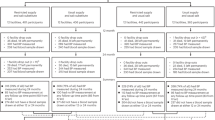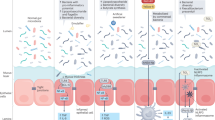Abstract
RECENTLY, Klemperer et al. 1 and Grier et al. 2 demonstrated the inhibitory effect of low concentrations of beryllium salts on alkaline phosphatase in vitro. This action was found to be rather specific3 and we hoped to be able to shed new light on the old controversy concerning intestinal sugar absorption4,5 and the role of alkaline phosphatase. Into isolated parts of the rat's small intestine, left in situ, we introduced solutions of glucose with or without added beryllium sulphate. There was no difference in the rate of absorption of glucose. Any conclusion from these experiments, however, is dependent on whether the phosphatase is inhibited in vivo as it is in vitro. Klemperer3 suggested that interference with phosphatase action is related to the toxicity of beryllium. This would include an action on phosphatase in vivo. It seemed necessary, however, to obtain more conclusive evidence about this problem, especially about the mode of action of beryllium salts on alkaline phosphatase. Klemperer et al. 1 and Grier et al. 2 considered the possibility that, owing to the amphoteric properties of beryllium hydroxide, beryllate ions might be the inhibiting agent at the pH of optimal enzyme activity. We confirmed the observation of the first-named authors that the relative inhibition increases with increasing pH, reaching a constant high value at the pH of optimal enzyme activity; but we must agree with them that no conclusion can be drawn therefrom as to the form in which beryllium is active as an inhibitor. Treadwell and Boner6, however, clearly demonstrated that beryllate ions do not exist at a pH lower than 12.5. At the pH of optimal enzyme activity (9.6) practically all the beryllium will be in the form of precipitated (colloidal) beryllium hydroxide.
This is a preview of subscription content, access via your institution
Access options
Subscribe to this journal
Receive 51 print issues and online access
$199.00 per year
only $3.90 per issue
Buy this article
- Purchase on Springer Link
- Instant access to full article PDF
Prices may be subject to local taxes which are calculated during checkout
Similar content being viewed by others
References
Klemperer, F. W., Miller, J. W., and Hill, C. J., J. Biol. Chem., 180, 281 (1949).
Grier, R. S., Hood, M. B., and Hoagland, M. B., J. Biol. Chem., 180, 289 (1949).
Klemperer, F. W., J. Biol. Chem., 187, 189 (1950).
Verzár, F., et al., Biochem. Z., 270, 35 (1934); 259, 398 (1933).
Westenbrink, H. G. K., Nature, 138, 203 (1936).
Treadwell, W. D., and Boner, J. E., Helv. Chim. Acta, 17, 774 (1934).
Kroon, D. B., Neumann, H., and Krayenhoff Sloot, W. J. A. Th., Enzymol., 11, 186 (1944).
Author information
Authors and Affiliations
Rights and permissions
About this article
Cite this article
VEERKAMP, T., SMITS, G. Mode of Action of Beryllium on Alkaline Phosphatase. Nature 172, 589–590 (1953). https://doi.org/10.1038/172589a0
Issue Date:
DOI: https://doi.org/10.1038/172589a0
Comments
By submitting a comment you agree to abide by our Terms and Community Guidelines. If you find something abusive or that does not comply with our terms or guidelines please flag it as inappropriate.



